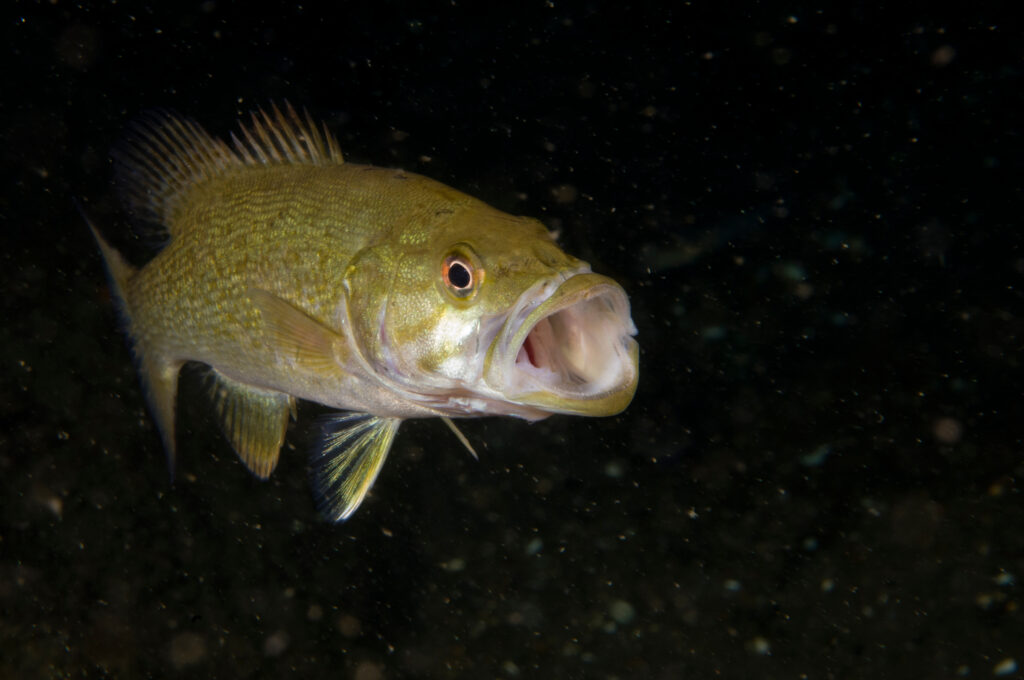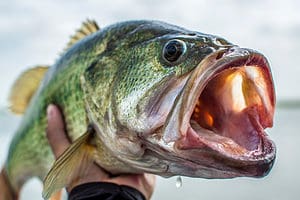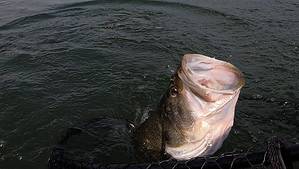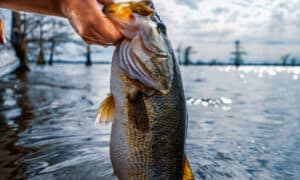Smallmouth bass are one of North America‘s most popular species for sport or recreational fishing. They have abundant populations that expand across the United States, and because smallmouth bass are so aggressive, many types of baits and lures work for them. Although a smaller fish on average, you won’t believe some of the record-breaking sizes, including the largest smallmouth bass ever caught in South Carolina.
Description of Smallmouth Bass

Smallmouth bass are generally golden-olive in color, fading to dark brown on the dorsal side.
©K Steve Cope/Shutterstock.com
Although slender, the fusiform shape of the smallmouth bass makes them efficient swimmers. Fusiform is when the body is tapered at both ends, giving it a spindle-like shape. However, these fish are also very muscular, which helps them maneuver through fast currents.
Smallmouth bass are generally golden-olive in color, fading to dark brown on the dorsal side. As you move to the ventral side, the coloring brightens to yellow. Over the main body, dark brown vertical blotches may be observed, contributing to this fish’s fantastic camouflage in the water. But, the coloration of the smallmouth bass can vary depending on the habitat and diet.
Smallmouth Bass Size
On average, the males are smaller than the females. Male smallmouth bass grow to about two pounds, on average. In contrast, female smallmouth bass may grow to about three to six pounds.
Smallmouth bass usually develop to be 10-20 inches in length. However, the longest smallmouth bass grew to an incredible 27 inches!
Diet

Smallmouth bass are carnivorous fish whose diet consists primarily of small fish, insects, crustaceans, and other aquatic organisms.
©RLS Photo/Shutterstock.com
Smallmouth bass are carnivores and are described as opportunistic hunters. That means that smallmouth bass have a wide variety of prey they may consume when it comes to foraging. They can adapt to whatever prey is available in their habitat, making them mighty hunters.
Young smallmouth bass consume zooplankton, insect larvae, crayfish, and sometimes smaller fish. However, when they grow to be adults, smallmouth bass eat insects, tadpoles, amphibians, crayfish, other species of fish, or even the young of other smallmouth bass. However, crayfish usually comprise 50 percent of the bass’s diet.
These fish are most active right away in the day, from dawn until mid-morning. Then, smallmouth bass will feed again in the late afternoon until dusk. These are advantageous times for hunting because crayfish have trouble seeing in the low light, giving the bass the upper hand. When it gets warm in the summer, bass may also feed at night.
Habitat
Smallmouth bass like freshwater environments like streams, rivers, lakes, and reservoirs. They are drawn to cooler waters, so you will often find them in deep waters with quick currents in the summer. They also don’t tolerate pollution well, though they are more adaptable than trout. So if there are abundant smallmouth bass in a lake, you know that the environment is clean and thriving.
Best Time to Fish for Smallmouth Bass

The best time to fish for smallmouth bass is fall.
©CLP Media/Shutterstock.com
Smallmouth bass are most active from spring through fall. During the winter, smallmouth bass will leave shallow shores for deeper parts of a lake or reservoir, which are not as cold. In rivers or streams during the winter, the smallmouth bass gravitates to eddies or other slow-current areas where they don’t have to expend much energy moving.
The best time of year to target smallmouth bass is during the fall. They will congregate close to shore, foraging for food as they store fat for the winter. Because they feed heavily, many types of lures will catch these ravenous fish. Focusing on low light periods during the day, like after dawn or before dusk, is the best time to catch smallmouth bass. As mentioned earlier, smallmouth bass have the advantage when hunting crayfish and the like in times of low light.
The Largest Smallmouth Bass Ever Caught in South Carolina
Terry Dodson holds the record for the largest smallmouth bass ever caught in South Carolina. In 2001, Dodson went out for some night bass fishing on Lake Jocassee and reeled in a nine-pound seven-ounce smallmouth bass! It was 24.5 inches long with a girth of 19.5 inches.
David Hayes is the world record holder for the largest smallmouth bass ever caught. The bass he reeled in on July 9, 1955, was a whopping 11 pounds and 15 ounces. He caught this colossal smallmouth bass in Dale Hollow Reservoir, Tennessee. This reservoir is renowned for yielding huge smallmouth bass.
However, after 41 years of holding the record, Hayes was temporarily removed after (false) rumors that the dock owner had added a lead weight to the catch. However, after several polygraph tests and a sworn affidavit, Hayes’ catch was determined to be legitimate, and the world record title returned to him.
Thank you for reading! Have some feedback for us? Contact the AZ Animals editorial team.








